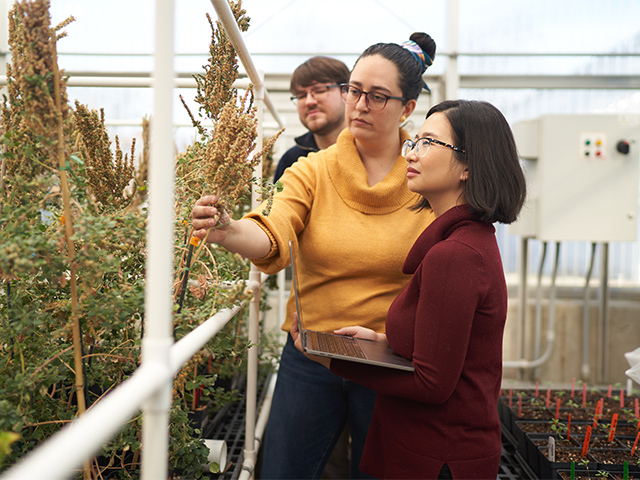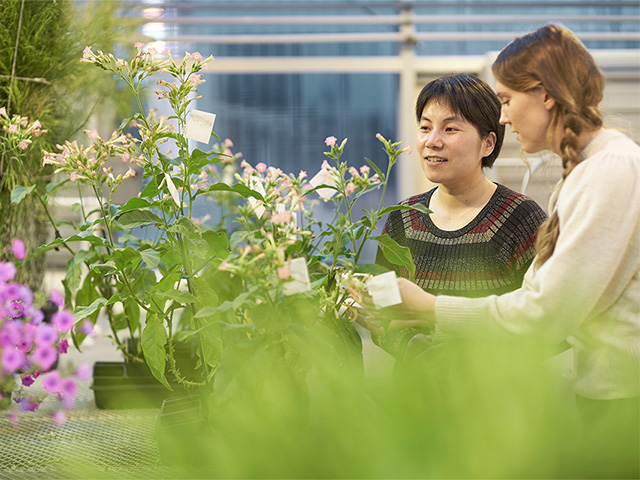How Plants Handle Heat — And What That Means for the Food We Eat
Summer heatwaves are common in St. Louis and across many parts of the U.S. The impact of extreme temperatures can dampen outdoor activities, wreak havoc on lawns and gardens, and most importantly challenge food producers. When visitors come to the Danforth Center, they are greeted by our thriving prairie landscape where plants thrive, year after year, despite no irrigation water, no pesticides and no fertilizers.
If we can understand how those native prairie plants have adapted to the stresses of temperature extremes, drought, pests and diseases, we can apply that knowledge to improve the resilience of agricultural crops.
Heat stress is a difficult problem to understand. Much work has focused on the molecular details of stress responses in model plants, like Arabidopsis, and in a few major crops. But what we’ve learned does not always scale to understand how plants in agricultural and complex ecosystems cope with heat stress. Also, while it is clear that plants can evolve and adapt in heat-stressed environments over long periods of time, different plant species do these in very different ways. That means improving heat stress tolerance in different crops will likely require diverse approaches.
A considerable amount of research at the Danforth Center is dedicated to understanding mechanisms underlying heat stress adaptation in plants, and to how quickly apply that knowledge to safeguard crop productivity in a warming world.

Malia Gehan, PhD and her team study diverse crop species (quinoa, maize, and brachypodium,a model grass related to wheat and rice) to compare the mechanisms and strategies plants have evolved to respond to heat. There can even be large differences in heat response within a species because they have become adapted to their local environments. For example, Oliver Walters-Clift, a summer intern participating in our REU Field and Laboratory Learning in Plant Science program is working on a project with Autumn Brown and Sam Kenney in the lab, to understand how heat is impacting pollen viability in a quinoa variety that is higher yielding in heat than a widely used research variety. By understanding the range of responses and natural variation, we can better prepare crops for the future.

Heat stress affects photosynthesis. Plants feed the world, and the sun feeds the plants. Photosynthesis, which mostly occurs in green tissues of plants, harvests sunlight, uptakes carbon dioxide to make food we eat and releases oxygen that we breathe. Photosynthesis is the key driver for food production and biomass accumulation in plants, but it is one of the most heat sensitive functions in plant cells. High temperatures damage the photosynthetic apparatus, decrease photosynthetic efficiency, and reduce agricultural yields. It is critical to understand how photosynthesis responds to high temperatures and how to improve the thermotolerance of photosynthesis.
Ru Zhang, PhD and her team investigate how plants respond to high temperatures, with a focus on heat effects on photosynthesis by using both green algae (Chlamydomonas reinhardtii) and land plants (Setaria viridis) as models. Chlamydomonas is an unicellular alga and swimming photosynthesizer which has genes with highly similar functions in photosynthesis as land plants. Setaria is a foxtail grass, which is closely related to staple crops like maize and sorghum. Using these model organisms with shorter life cycles, the Zhang lab aims to accelerate gene function analysis related to photosynthesis and identify strategies to improve photosynthesis and plant growth under high temperatures. Two undergraduate interns, Elizabeth Dill and Amarachi Ejimadu, worked on photosynthesis in Chlamydomonas and Setaria in the Zhang lab during the summer of 2025.
To learn more about our science, sign up for our newsletter and follow us on LinkedIn, @Donald Danforth Plant Science Center.